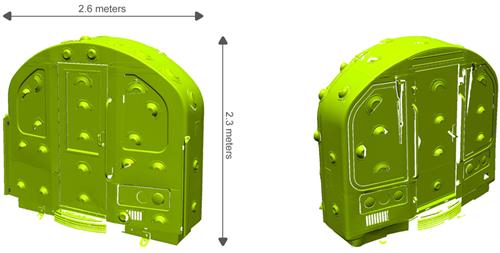3D scanning of large objects, such as trains, can be challenging. First of all, we can't get the train to the special measuring shop. However, the simple point-to-point measurement cannot fully understand the difference between the vehicle and the design and the deformation situation, and the white light 3D scanning provides a new solution.

Picture: Train scan results - 2.6m wide and 2.3m high
The HDI Advance from Ling Cloud can easily solve the problem of scanning large objects because it is a very portable and flexible product. Can accurately measure a mobile phone, but also can accurately obtain the front of the train three-dimensional contour. The HDI Advance can be easily mounted on the jib to photograph the top of the train from up to 5 meters in the air. With wide field of view and great depth of field, it is easy to capture clear images.
The following are the matters needing attention when scanning large objects:
1. Use highly accurate calibration plates
3D scanning of large objects requires really high precision calibration plates. Large calibration plates are expensive to make, but if you have a lot of 3D scans of this scale, it is worthwhile to make large calibration plates. On the other hand, the acquisition of 30 to 40 corrected images will help reduce the impact of distortion, thus improving accuracy and reducing post-processing time.
2. Minimize environmental impacts
Modifying the environment as much as possible to reduce ambient light interference will really help reduce noise. For very large objects, often outdoors, this often means scanning at night. You need to make sure that the object and the 3D scanner are completely still before capturing the 3D scan, but this is not easy. Also, make sure the projector vents are not in front of the lens, as this will affect the 3D scan data of the workpiece. You can use live image zooming to check for relative motion or thermal deformation to make sure there is no change.
3. Collect enough geometric features
Scanning large objects, such as trains, requires you to go back and forth looking for reference features, and making sure there are enough geometric features in each frame is crucial for stitching. If there are not enough natural features, some features can be added artificially. The alignment function of HDI Advance is very powerful, and in the case of enough geometric features, the stitching task can be completed very well.